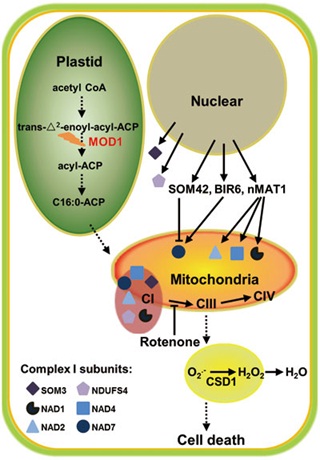Programmed cell death (PCD) is a genetically regulated process of cell suicide, which is of fundamental importance to development and defense in animals and plants. In animals, mitochondria play a central role in initiating PCD by integrating diverse stress signals and the intracellular homeostasis of reactive oxygen species (ROS) is crucial in regulating cell death and cell survival. In plants, a well-recognized form of PCD is hypersensitive response (HR) triggered by pathogens, which involves the generation of reactive oxygen species (ROS) and other signaling molecules. While the mitochondrion is a master regulator of PCD in animals, the chloroplast is known to regulate PCD in plants. It remains unclear whether mitochondria and mitochondria-derived ROS play a crucial role in triggering PCD in plants.
The group of Prof. LI Jiayang from the Institute of Genetics and Developmental Biology, Chinese Academy of Science, has long-term interests in the molecular mechanism of PCD in plants. They found that Mosaic Death 1 (MOD1), an enoyl-acyl carrier protein (ACP) reductase essential for fatty acid biosynthesis in chloroplasts, negatively regulates PCD in Arabidopsis (Mou et al., Plant Cell, 12: 405, 2000).
In a recent study, they have provided convincing evidence to reveal that PCD in mod1 results from accumulated ROS and can be suppressed by mutations in mitochondrial complex I components, and that the suppression is confirmed by pharmaceutical inhibition of the complex I-generated ROS. Further study shows that intact mitochondria are required for full HR and optimum disease resistance to the Pseudomonas syringae bacteria. These findings strongly indicate that the ROS generated in the electron transport chain in mitochondria plays a key role in triggering plant PCD and highlight an important role of the communication between chloroplast and mitochondrion in the control of PCD in plants.
This work has been published online in Cell Research on April 24, 2015 (doi:10.1038/cr.2015.46), with Drs. WU Jian and SUN Yuefeng as the co-first authors. This research was supported by National Natural Science Foundation of China and Chinese Academy of Sciences.

Figure. A proposed model of programmed cell death in mod1. A proposed signaling pathway, showing the initiation and suppression of the mod1 cell death. (Image by IGDB)
AUTHOR CONTACT:
LI Jiayang
Institute of Genetics and Developmental Biology, Chinese Academy of Sciences, Beijing, China.
 Figure. A proposed model of programmed cell death in mod1. A proposed signaling pathway, showing the initiation and suppression of the mod1 cell death. (Image by IGDB)AUTHOR CONTACT:LI JiayangInstitute of Genetics and Developmental Biology, Chinese Academy of Sciences, Beijing, China.E-mail: jyli@genetics.ac.cn
Figure. A proposed model of programmed cell death in mod1. A proposed signaling pathway, showing the initiation and suppression of the mod1 cell death. (Image by IGDB)AUTHOR CONTACT:LI JiayangInstitute of Genetics and Developmental Biology, Chinese Academy of Sciences, Beijing, China.E-mail: jyli@genetics.ac.cn CAS
CAS
 中文
中文




.png)
